Hello hello,
I hope you had a nice summer and are enjoying the fall. What follows is an article about
industrial uses of fungi by Dr. Michelle Seidl and about the fungi
Epicoccum Dawn Yates. I hope you'll find them interesting and helpful.
With best wishes,
Dave Gallup
Industrial Uses of Fungi
By Dr. Michelle Seidl
Many fungi are useful to humans and have been exploited both industrially and commercially.
Societies have utilized fungi for centuries in a wide variety of ways by capitalizing on the
metabolism and metabolites (chemicals made from metabolism) produced. The oldest and best known
example is the use of yeasts performing fermentation in brewing, wine making and bread making.
Yeasts and other fungi play a critical role in drug production, food processing, bio-control
agents, enzyme biotechnology, as well as research and development.
The use of yeast (e.g. Saccharomyces cerevisae) to make alcohol and carbon dioxide uses
the fermentation process to break down sugars. Up to 50% of the sugar can be converted to alcohol,
but rarely surpasses 15% because the fungi are sensitive to high concentrations of alcohol. In
the beer making industry, cereal grains are fermented to make the final product. Wine is composed
of fermented grapes while hard cider is essentially fermented apples. Sake is produced by rice
fermentation, using Aspergillus oryzae and then an additional fermentation step utilizing
bacteria and yeasts. With bread making, fermentation utilizes sugar to produce carbon dioxide
and alcohol. The carbon dioxide produces the bubbles and causes bread to rise, while the alcohol
produced evaporates off while baking. A variety of foods and drinks are fermented before
consumption. Some of the largest industries in the west are based around production of alcohol
and bread. In the east, the production of soy sauce and other fermented soybean products are
likely among the largest industries. The peoples of Asia have developed a wide variety of
interesting fermented foods, sauces and drinks, using fungi. Other examples and the applicable
fungi include koji (Aspergillus); miso, soy bean paste (Aspergillus); sufu,
Chinese cheese (Rhizopus), nyufu or fuyu, bean cake or bean cheese (Rhizopus);
shoyu or soy sauce (Aspergillus, Saccharomyces) and tempeh (Rhizopus).
Another way in which fungi are used industrially in the food industry is in cheese production.
Various cheeses are inoculated with Penicillium roquefortii to impart a strong and pungent
flavor in the resultant cheeses. Examples are Roquefort, Gorgonzola, Stilton Blue and Danish Blue.
The white crust on the outside of the cheeses known as Brie and Camembert is the mycelium of
Penicillium camembertii. These strong flavors are a result of the fungus producing
methyl ketones.
Aspergillus
is utilized industrially in a number of ways. Most sodas and soft drinks contain citric acid as
a main ingredient. Citric acid is also used in other drinks, many candies, canned goods, baked
goods, etc. It is too expensive to isolate the citric acid from citrus fruits so it is produced
in large-scale fermentation vats utilizing Aspergillus niger. Authentic soy sauce is
fermented in a three-step process with the fungi Aspergillus oryzae and
Zygosaccharomyces rouxii, as well as the bacterium Pediococcus halophilus (Comm.
Dr. S. N. Rajagopal, Biological and Agricultural Engineering, Univ. AR).
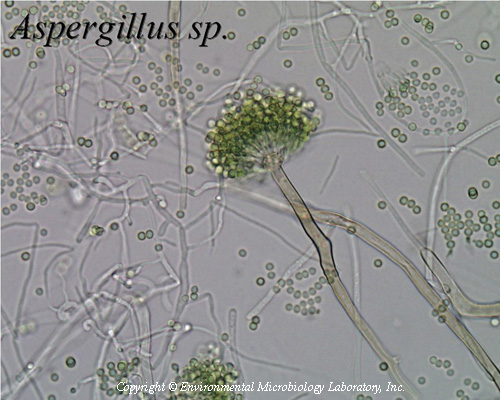
Aspergillus sp.
Copyright © 2006 Environmental Microbiology Laboratory, Inc.
Fungi are very useful organisms in biotechnology. They are important experimental organisms easily cultured, occupy little space, multiply rapidly and have a short life cycle. Many fungi are used as model organisms for genetics, cell biology and molecular biology. The now famous "one gene one enzyme" hypothesis in the ascomycete fungus Neurospora won Beadle and Tatum the Nobel Prize. Currently there are about 1,600 antibiotics commercially produced and a number of medical drugs are manufactured using various fungi. These multi-billion dollar industries include examples such as anti-cholesterol statins, the antibiotic penicillin, the immunosuppressant cyclosporins and steroids. Statins have been used to reduce cholesterol and prevent cardiovascular disease. The group of statins derived via fermentation include: lovastatin (first isolated from Aspergillus terreus and the first statin approved by the FDA in 1987), pravastatin (isolated from Nocardia autotrophica), and mevastatin (from the fungi Hypomyces, Paecilomyces, and Trichoderma, and a fermentation product of Penicillium citrinum). Since its discovery in 1941, the antibiotic penicillin from the fungus Penicillium notatum (often called P. chrysogenum) has revolutionized human health and disease treatment. Cephalosporins are another group of antibiotics originally produced by the fungus Cephalosporium (synonym of Acremonium). First discovered as a powerful immunosuppressant in the 1970's, cyclosporins are a primary metabolite of several fungi, including Trichoderma, Tolypocladium and Cylindrocarpon. Cyclosporins have proven to be useful in mammals, being widely used during and after bone marrow and organ transplants in humans. The steroid in "the pill" is produced industrially by the fungus Rhizopus nigricans. Steroids, such as cortisone (used in arthritis treatment) and prednisone, are manufactured with the help of molds.
The only useful antifungal agent from fungi is griseofulvin. The original source was Penicillium griseofulvin. Griseofulvin is fungistatic (inhibits fungal growth), rather than fungicidal (destroys fungi). It is used for the treatment of dermatophytes, as it accumulates in the hair and skin following topical application. These antifungal agents are readily and cheaply produced industrially.
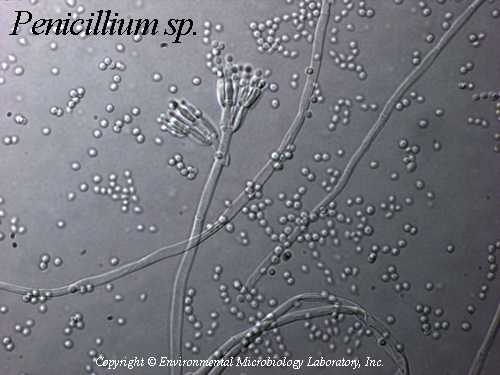
Penicillium sp.
Copyright © 2006 Environmental Microbiology Laboratory, Inc.
Ergot alkaloids have a number of medicinal uses, the most widespread being migraine treatment.
The vasodilator activity reduces tension during an attack. These alkaloids are now produced
industrially in culture using strains of Claviceps.
A number of industrial applications use the biological activity of fungi involved in the
alteration of plant cell walls. Fungi are able to break down plant cell walls by the production
of a wide variety of enzymes. Enzymes are used to treat and modify fibers, particularly during
textile processing and in caring for textiles afterwards. For example, enzymes called catalases
are used to treat cotton fibers and prepare them for the dyeing processes. By degrading surface
fibers, many enzymes, including some cellulases and xylanases, are used to finish fabrics, help
in the tanning of leathers or give jeans a stonewashed effect. Stonewashed jeans are placed in
a large vat containing the fungus Trichoderma, which produces enzymes (cellulases)
that partially digest the cotton fibers of the jeans to add softness and produce the stonewashed
look. The natural enzyme supplement Beano™, contains the enzyme (α-galacatosidase)
from Aspergillus terreus, used for digestive discomfort. The pulp and paper industry
benefits from the enzyme production capabilities of certain fungi to soften wood fibers and
provide alternatives to chemical bleaching. For example, the basidiomycetes Trametes
and Phanerochaete are used for lignin biodegradation and Bjerkandera is used
for hardwood cellulose bio-bleaching by producing the enzymes peroxidase and xylanase. Certain
fungi are the primary source for xylanases, which are used industrially to breakdown xylan,
the second most abundant polysaccharide in nature.
Enzymes are a sustainable alternative to the use of harsh chemicals in industry. Because enzymes
work under moderate conditions, such as warm temperatures and neutral pH, they reduce energy
consumption by eliminating the need to maintain extreme environments, as required by many
chemically catalyzed reactions. Reducing energy consumption leads to decreased greenhouse gas
emissions. Enzymes also reduce water consumption and chemical waste production during
manufacturing processes. Because enzymes react to specific situations and minimize the
production of by-products, they offer minimal risk to humans, wildlife, and the environment.
Enzymes are both economically and environmentally beneficial because they are safely inactivated
and create little or no waste; rather than being discarded, end-product enzymatic material may
be treated and used as fertilizer. Enzyme research using fungi has been very active and
promising in recent years. For example the enzyme laccase produced from different fungi was
used to make paper. This process led to a 30% reduction in energy consumption, a 50% reduction
in chemical product usage and a greater resistance to tearing.
Enzymes are also used to make food more edible or desirable by removing, adding or modifying
components such as vitamins, nutritional elements, colors and flavors. Fungi are a common
contributor to the processing of foods. Certain fungi produce a range of compounds that alter
the color of food. For instance, Monoascus purpureus has been traditionally used for
the production of red wine. The pigments are polyketides that are insoluble in acid conditions.
A range of zygomycete fungi in the Mucorales produces beta-carotene, commonly added to a variety
of foods. A recent concern with the potentially toxic or allergic reactions of some artificial
coloring agents has led to a closer examination of colors from these natural sources. Used in
animal nutrition and food enrichment, the biocatalytic production of vitamin B2
(riboflavin) replaced chemical synthesis in the early 1990's. It is now commonly produced by
fermentation of the ascomycete fungus Ashbya gossypii. Since large quantities of
enzymes are often needed for industrial usage, fermentation vats fulfill this need.
Fungal food items are also produced on an industrial scale. For instance, edible mushrooms are
grown on large-scale farms. These delicious and nutritious natural products have seen a large
increase during the past few decades. Many contain a protein profile that rivals that of beans
and most contain large amounts of B vitamins and minerals. Another food product example is
Quorn™, the brand name of an all-natural, meat-free frozen food. Quorn™ brand has
been sold in the UK since 1985. In 2002 it was launched in the U.S. and has since become the
best-selling frozen meat-free brand in natural food stores. It can be found in various meat-like
forms such as patties, (veggie) dogs, roasts, and tenders (similar to chicken nuggets). This
efficient and nutritious protein source consists of a mycoprotein from the fungus Fusarium
venenatum.
In the various fields of agriculture, medicine, environmental biology, biotechnology, research
and development; fungi provide novel and important products and applications. Their extraordinary
usefulness has provided us with numerous advantageous products and will undoubtedly afford us
with additional medicines, foodstuffs, enzymes, amenities and other valuable items in the future.
CORRECTION: The original September 2006 issue of Environmental Reporter misstated the enzyme
responsible for the active ingredient in Beano™. The correct enzyme is alpha-galactosidase.
References:
1. Alexopoulos, C.J., C.W. Mims, M. Blackwell. 1996. Introductory Mycology. John Wiley & Sons, USA.
2. Beg, Q.K., M. Kapoor, L. Mahajan, G.S. Hoondal. 2004. Microbial xylanases and their industrial applications: a review. Appl. Microbiol. and Biotech. Springer Berlin/Heidelberg.
3. Gow N. & Gadd G.M. (Eds)(1995) The Growing Fungus. Chapman Hall, London.
4. http://www.TomVolkFungi.net
5. History of Fermented Tofu
6. Wainwright M. (1995) An Introduction to Fungal Biotechnology. Wiley, Chichester.
7. The Biodiversity of Filamentous Fungi
8. Quorn™ website
Fungus of the Month: Epicoccum
By Dawne Yates
Epicoccum (phonetic: Epp-ee-cock-um) is a very common fungus that is an early secondary invader on all sorts of plants, particularly damaged plant tissue, and is often found on leaf spots with other fungi. It has been isolated from air, moldy paper, plant materials, animals, insects, foodstuffs, textiles, soil, and occasionally occurs in house dust. It is mostly saprophytic (obtaining food from dead or decaying organic matter), or weakly parasitic. It is ubiquitous in nature (found everywhere) and is commonly found in outdoor air. It is known to be very resistant to changes in water activity; having been known to resume growth after long periods of drying.
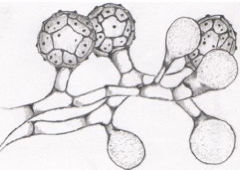

Figure 1: Drawings of Epicoccum
Copyright © 2006 Environmental Microbiology Laboratory, Inc.
Spores are produced very quickly and our MoldRange™ data shows the highest recovery rate, of about 30% to 35%, in the summer and the lowest recovery rate, of about 10% to 15%, in the winter. See Figure 2 below.
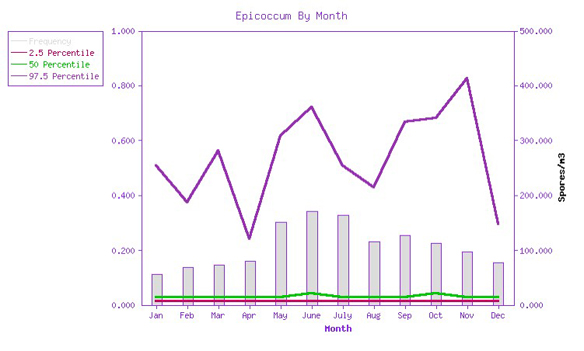
Figure 2: Frequency of detection and spore density by month for Epicoccum.
The gray bars represent the frequency of detection, from 0 to 1 (1=100%), graphed against the left axis. The red, green, and purple lines represent the 2.5, 50, and 97.5 percentile airborne spore densities, when recovered, graphed against the right hand axis. (Source: EMLab™ MoldRange data. Total sample size for this graph: 39,878.)
Morphology:
In culture, Epicoccum is fast growing on general fungal media, and produces colonies which are woolly and/or downy in appearance. Colony colors include yellow, orange, red or brown. As the colony ages they usually become darker and black dots (spores growing on colonies) may be observed on the colony surface. These are tufts of hyphae that are cushion-shaped, non-convoluted and are called sporodochium (a cushion-like mass of conidiophores, conidia and conidiogenous cells produced above the substrate).
When observed on spore trap samples, immature Epicoccum spores may look round, non-septate, and may be pale in color, whereas when they are mature, can appear rough, warty-looking and brown to black in color, with both transverse and oblique septa, which makes them resemble a soccer ball. The broad attachment area at the base is often visible. Mature spores are most commonly 15-25 µm in diameter, but are also seen smaller and much larger (up to 50 µm diameter). Intact spores are distinctive, however young immature spores may be confused with Ulocladium, Stemphylium or possibly Alternaria. On a tape lift, Epicoccum is easily distinguishable providing the growth is mature enough to include the conidiophores and conidia.
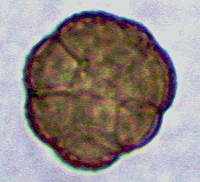
Figure 3: Single Epicoccum spore in air sample.
Copyright © 2006 Environmental Microbiology Laboratory, Inc.
Health Effects:
Epicoccum has been known to cause Type 1 allergies (hay fever and asthma). Rarely, it can cause infections in the skin due to its ability to grow at 37°C.
References:
1. Barron, G.L. "The Genera of Hyphomycetes From Soil"
2. Ellis, M.B. "Dematiaceous Hyphomycetes"
3. Watanabe, T. "Pictorial Atlas of Soil and Seed Fungi"

